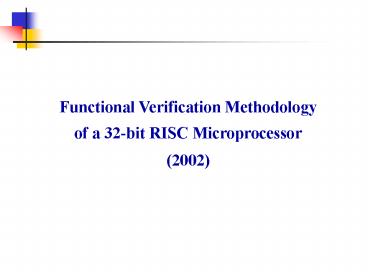Functional Verification Methodology PowerPoint PPT Presentation
1 / 17
Title: Functional Verification Methodology
1
Functional Verification Methodology of a 32-bit
RISC Microprocessor (2002)
2
Outline
- Introduction
- Verification Strategy
- Verification Environment
- Results for FDU32
3
Introduction
- Development of VLSI technology and design of
more µps with - complicated structures that can be implemented
on a single chip - result in a lot of problems for Functional
Verification (FV) of the - µps.
- 2 major methods for FV of µps
- Formal Verification that has not yet available
for commercial products - Simulation-based Verification that is still prime
method
- Method 2 applies TBs to a design and a reference
model. Thus, selection of the proper strategy to
generate TBs is important.
4
Introduction (cont.)
- In Simulation-based Verification for µps, TBs can
be generated by using - Pseudo-random method -gt efficiency is low
(redundant TBs) - Pipeline-focus method -gt reliability is low since
it could not verify the non-pipeline cases
- This paper presents a verification strategy that
combines - pseudo-random and pipeline-focus generating
methods. - In this way, both the high efficiency and the
high reliability - can be ensured.
- FDU32 is used for this verification strategy
that is a 32-bit RISC - µp compatible with ARM7 instruction set which
has 32-bit addr - and data bus with a 5-stage pipeline
(IF,ID,EXE,MEM,WB).
5
- Introduction
- Verification Strategy
- Verification Environment
- Results for FDU32
6
Verification Strategy
- In order to evaluate a verification strategy, the
processor model has to be setup first.
- Processor Model
- Its better that the processor model be a
model that can be used generally. - Thus, the details such as addressing range
have to be ignored. - In the pipeline, each stage can be treated as
an independent - functional block named as pipeline unit.
- Pipeline States
- A processor with k-stage pipeline and n
kinds of instructions - has states.
7
Verification Strategy (cont.)
- Kinds of Instructions
- 1. DTI (Data Transformation Instructions)
- 2. DOI (Data Operation Instructions)
- 3. PCI (Program Control Instructions)
- 4. NOP (No Operation)
- Thus, a 5-stage pipeline processor model has
states.
- A 5-stage pipeline structure will result in
pipeline hazards.
- H(s1,i1,s2,i2) (i1,s1),(i2,s2) represent
Inst. in diff. pipeline states
- By using MATLAB simulation it can be shown that
2366 states - can cause the pipeline hazards. Thus, the
processor model is - appropriate for the analysis of pipeline-focus
generating method.
8
Verification Strategy (cont.)
- Comparison of Different Verification Strategies
- Efficiency of pipeline-focus is high, but it
can not verify some non- - pipeline hazards.
Fig. 2 Coverage of pipeline states for a
combination of two methods
Fig. 1 Coverage of pipeline states
for pseudo-random and pipeline focus methods
9
Verification Strategy (cont.)
- To verify the non-pipeline states with
auto-generating method - is difficult, sometimes even impossible, for
example arbitrating - the propriety of different interruptions.
Thus - Handwrite method has to be applied
- To have the best efficiency and
- reliability of the FV, different TB
- generating techniques have to be
- employed during different stages.
Fig. 3 Coverage of processor states (including
Pipeline and non-pipeline states) for a
combination of handwrite and auto-generating
methods
10
Verification Strategy (cont.)
- Combined Verification Strategies
- The 3-stage bottom-up verification strategy
- First step
- At the beginning of the verification, the
purpose is to - verify the basic function of each module,
and not many - TBs are needed. Thus, the handwrite method
which has - a good focus can be used.
11
Verification Strategy (cont.)
Second step The overall function and the
interfaces between the blocks are verified.
Both pseudo-random and pipeline-focus
methods are used. The amount of the TBs is bigger
than that of first step.
Third step The handwrite method is used to
verify the corner cases, and through the
code coverage analysis the uncovered
code is pointed out.
12
- Introduction
- Verification Strategy
- Verification Environment
- Results for FDU32
13
Verification Environment
- Depending on the verification
- strategy, an environment has
- been setup to implement the
- strategy (Fig. 4)
- A command file is created to
- define the initial state and some
- control information.
- Because of time-to-market
- limitation and complication of
- circuit design, its impossible to
- create the exhaustive TBs. Hence,
- in order to guarantee the reliability
- of the FV, code coverage analysis
- is needed.
Fig. 4 Verification environment
14
- Introduction
- Verification Strategy
- Verification Environment
- Results for FDU32
15
Results for FDU32
- According to verification strategy and
verification environment, - FDU32 was verified.
- 38.9 of bugs was found by
- pipeline-focus method and
- 33.3 by pseudo-random
- method, in total 72.2.
- Code coverage analysis was
- carried-out to complete the
- verification.
Fig. 5 The bug percentage found by different
TB generating methods
- During FPGA verification, little design bugs was
found which - reinforce the efficiency and reliability of
the proposed VS.
16
Results for FDU32
- Conclusion
- Using a combined technique including
pipeline-focus generating - method and pseudo-random generating method,
leads to great - improvement on the automation and efficiency of
the verification - process.
- Using the handwrite generating method and code
coverage - analysis, leads to further enhancement of the
reliability of the - verification.
17
Any Question?

